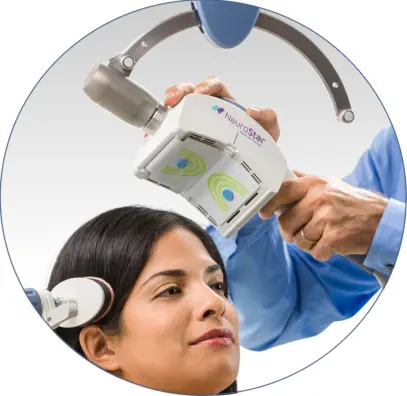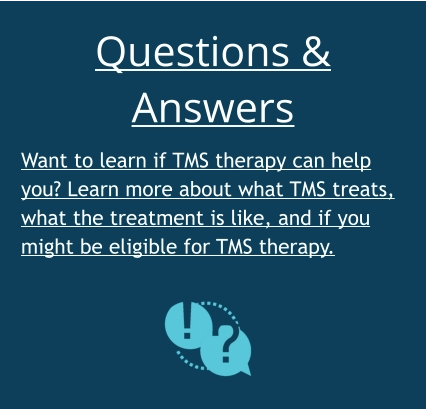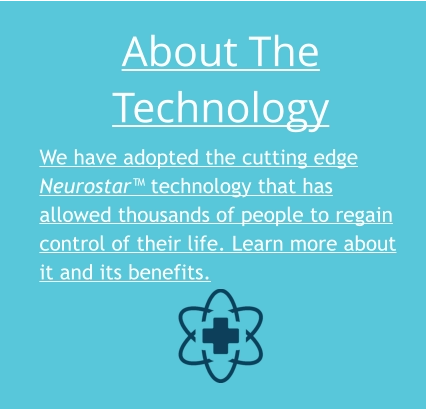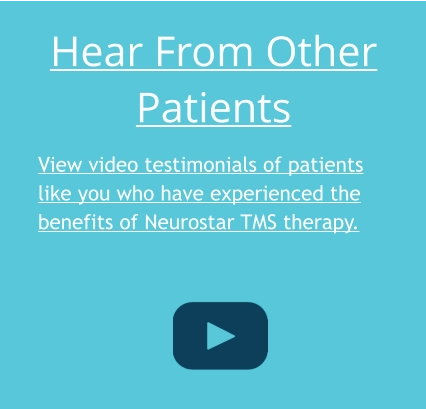
Is TMS right for me?
If you suffer from long-term depression that has not responded well to other treatments then TMS Therepy may help where other treatments have not been effective. The best way to understand your options and whether TMS might work for you is to speak with one of our highly qualified providers. You can request a phone call with one of our providers through our private contact form.Why try TMS?
Depression and obsessive-compulsive disorders are traditionally treated by talk therapy, antidepressants, and other drugs. When these interventions fail patients are often frustrated by the cycle of trying new prescriptions and their associated side effects, often with little or no improvement to their quality of life. TMS is an entirely different approach that has been clinically proven to be effective and safe. The human brain operates by electric charges which create chemical changes. It is a chemical imbalance that contributes to depression or compulsive behavior, and many other brain health disorders.What does Transcranial Magnetic Stimulation (TMS) treat?
TMS has been approved by the FDA as a therapy for depression since 2008. In 2013 and 2018, respectively, the therapy was further approved for the treatment of migraine headaches and obsessive-compulsive disorders. Today there are numerous clinical trials being held in the United States that show great promise for those suffering from many other disorders. In Europe TMS has been in use for over 30 years and is currently also cleared to treat bipolar disorder, epilepsy, Alzheimer’s disease, epilepsy, Parkinson’s disease, chronic pain, smoking cessation, PTSD, and some cases of schizophrenia. Medicare and most medical insurance plans provide coverage for TMS therapy.
Your first session will map the electrical signals in your brain in order to accurately map your
individual brain regions for therapy. While you are comfortably seated technicians will place a
magnetic coil over the treatment area. The magnetic pulses generated will in turn induce an aimed
therapeutic electric charge at those brain regions.
This electrical re-enervation renews the function of under-active nervous system cells, essentially
solving the imbalance correlated to mood, and restoring mental well-being.
There is generally no discomfort during the therapy; side effects are mild and rare.
Treatment is applied in a relaxed sitting position by the placement of the Neurostar device near
your forehead.
After locating the distinct brain area for treatment, and the initial stimulation session, patients
return to the office regularly over 5 to 8 weeks. These appointments will last about 30 minutes.
Following your session you can expect little or no side effects, and you will begin to notice
improvements to your mood, outlook, and motivation.
How does TMS work?
When we place the Neurostar appliance on your scalp, according to your digital brain map, magnetic pulses will electrically enervate brain cells that are identified as functioning poorly. When effectively activated, these neural connections tend to “learn” this healthy state, and throughout the sessions patients increasingly report an overall, often dramatic sense of increased well-being.
Want to learn more about TMS Therapy?
Ready to get started with TMS Therapy?

©2021 Eola Counseling - All Rights Reserved
Our Locations
Dallas, Oregon
2200 East Ellendale
Dallas, OR 97338
Salem Oregon
401 E Ratcliff, Suite 130
Salem OR 97302
Want to learn more about TMS Therapy?

Is TMS right for me?
If you suffer from long-term depression that has not responded well to other treatments then TMS Therepy may help where other treatements have not been effective. The best way to understand your options and whether TMS might work for you is to speak with one of our highly qualified providers. You can request a phone call with one of our providers through our private contact form.Why try TMS?
Depression and obsessive-compulsive disorders are traditionally treated by talk therapy, antidepressants, and other drugs. When these interventions fail patients are often frustrated by the cycle of trying new prescriptions and their associated side effects, often with little or no improvement to their quality of life. TMS is an entirely different approach that has been clinically proven to be effective and safe. The human brain operates by electric charges which create chemical changes. It is a chemical imbalance that contributes to depression or compulsive behavior, and many other brain health disorders.What does Transcranial
Magnetic Stimulation (TMS)
treat?
TMS has been approved by the FDA as a therapy for depression since 2008. In 2013 and 2018, respectively, the therapy was further approved for the treatment of migraine headaches and obsessive- compulsive disorders. Today there are numerous clinical trials being held in the United States that show great promise for those suffering from many other disorders. In Europe TMS has been in use for over 30 years and is currently also cleared to treat bipolar disorder, epilepsy, Alzheimer’s disease, epilepsy, Parkinson’s disease, chronic pain, smoking cessation, PTSD, and some cases of schizophrenia. Medicare and most medical insurance plans provide coverage for TMS therapy.
Your first session will map the electrical
signals in your brain in order to accurately
map your individual brain regions for
therapy. While you are comfortably seated
technicians will place a magnetic coil over
the treatment area. The magnetic pulses
generated will in turn induce an aimed
therapeutic electric charge at those brain
regions.
This electrical re-enervation renews the
function of under-active nervous system
cells, essentially solving the imbalance
correlated to mood, and restoring mental
well-being.
There is generally no discomfort during the
therapy; side effects are mild and rare.
Treatment is applied in a relaxed sitting
position by the placement of the Neurostar
device near your forehead.
After locating the distinct brain area for
treatment, and the initial stimulation
session, patients return to the office
regularly over 5 to 8 weeks. These
appointments will last about 30 minutes.
Following your session you can expect little
or no side effects, and you will begin to
notice improvements to your mood,
outlook, and motivation.
How does TMS work?
When we place the Neurostar appliance on your scalp, according to your digital brain map, magnetic pulses will electrically enervate brain cells that are identified as functioning poorly. When effectively activated, these neural connections tend to “learn” this healthy state, and throughout the sessions patients increasingly report an overall, often dramatic sense of increased well- being.
OregonTMS

What is TMS treatment like?
Dallas, Oregon
2200 East Ellendale
Dallas, OR 97338
Salem Oregon
401 E Ratcliff, Suite 130
Salem OR 97302
Our Locations
Want to learn more
about TMS Therapy?
Ready to get started
with TMS Therapy?
©2021 EOLA Mental Health Services
All Rights Reserved






























